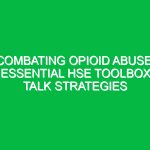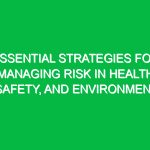Slips, trips, and falls are among the leading causes of workplace injuries, accounting for a significant percentage of accidents reported each year. In the realm of Health, Safety, and Environment (HSE), understanding how to avoid slips, trips, and falls in the workplace is essential not only for compliance but also for fostering a safe working environment. This article delves deep into the various strategies, best practices, and Regulations that can help minimize these risks, ensuring the well-being of employees and enhancing overall Workplace Safety culture.
Understanding the Risks
Before we explore how to avoid slips, trips, and falls in the workplace, it is crucial to understand the risks associated with these accidents. Slips occur when there is a loss of traction between the footwear and the walking surface. Common causes include wet floors, spills, and slippery surfaces. Trips happen when a person’s foot strikes an object, causing them to lose balance, often due to uneven surfaces, clutter, or poor lighting. Falls can result from slips and trips, leading to serious injuries, including fractures, sprains, and concussions.
The implications of these accidents are not just physical; they can lead to increased insurance costs, reduced employee morale, and potential legal ramifications for employers. In a corporate setting, a slip or trip can result in lost productivity and significant financial impacts. Recognizing and addressing these risks is the first step toward creating a safer workplace.
Effective Strategies for Prevention
1. Conduct Regular Risk Assessments
One of the most effective ways to learn how to avoid slips, trips, and falls in the workplace is through regular risk assessments. This involves identifying potential Hazards in the work environment that could lead to such accidents. For instance, a manufacturing facility might have wet floors due to machinery leaks, while an office might have loose carpeting or cluttered walkways.
Employers should schedule these assessments frequently and after any significant changes to the workplace, such as renovations or the introduction of new equipment. Engaging employees in this process can also provide valuable insights, as they are often the first to notice Hazards.
2. Improve Housekeeping Practices
Maintaining a clean and orderly workplace is crucial in preventing slips, trips, and falls. Employers should implement strict housekeeping protocols that include:
- Regularly cleaning spills immediately.
- Ensuring walkways are clear of obstacles and debris.
- Properly storing materials and tools when not in use.
- Organizing workspaces to minimize clutter.
A well-kept environment not only reduces the risk of accidents but also promotes a culture of Safety among employees.
3. Enhance Floor Safety
Floor surfaces play a significant role in slip, trip, and fall incidents. Organizations should evaluate their flooring materials and consider the following:
- Using slip-resistant flooring surfaces in high-traffic areas.
- Installing mats or rugs in entrance areas to capture moisture and dirt.
- Ensuring that floor surfaces are properly maintained and repaired.
Additionally, signage warning of wet floors or uneven surfaces can alert employees to potential hazards before accidents occur.
4. Promote Proper Footwear
Employees should be encouraged to wear appropriate footwear that provides good traction and support. Employers may consider implementing a footwear policy, especially in environments prone to slips and trips. For instance, non-slip shoes can significantly reduce the likelihood of accidents in kitchens, warehouses, and manufacturing plants. In an office setting, advising employees to avoid high heels or overly slick-soled shoes can also help mitigate risks.
5. Improve Lighting Conditions
Poor lighting can contribute to slips, trips, and falls. Employers should ensure that all areas of the workplace are adequately lit, especially stairways, hallways, and entrances. Regular Maintenance of light fixtures and prompt replacement of burnt-out bulbs are essential practices. Additionally, using motion-sensor lighting in less-frequented areas can enhance visibility and safety.
Training and Awareness
1. Employee Training Programs
Employee training is crucial in teaching workers how to avoid slips, trips, and falls in the workplace. Regularly scheduled training sessions should cover safe walking practices, proper use of equipment, and emergency Procedures in case an accident occurs. Providing real-life examples and scenarios can reinforce the importance of safety protocols. An anecdote from a manufacturing plant highlights this: after implementing a comprehensive training program, the facility reported a 50% decrease in slip and fall incidents within six months.
2. Encourage a Safety Culture
Encouraging a culture of safety in the workplace can significantly reduce accidents. This means fostering an environment where employees feel comfortable reporting hazards without fear of reprisal. Regular safety meetings can provide a platform for discussing safety concerns and sharing experiences. Involving employees in safety committees can also empower them to take ownership of Workplace Safety.
Regulations and Standards
1. OSHA Guidelines
In the United States, the Occupational Safety and Health Administration (osha) provides regulations aimed at preventing slips, trips, and falls. Employers are required to maintain a safe workplace and follow specific guidelines related to walking surfaces, stairways, and ladders. Familiarizing employees with OSHA standards can help ensure compliance and promote a safer environment.
2. International Standards
Many countries have established their regulations regarding Workplace Safety. For instance, the International Organization for Standardization (ISO) has developed standards that focus on risk management and safety practices. Companies should be aware of and comply with their local regulations and standards to avoid legal issues and enhance safety practices.
Conclusion
Understanding how to avoid slips, trips, and falls in the workplace is a vital aspect of promoting health, safety, and environmental Sustainability. By implementing effective strategies such as regular risk assessments, improving housekeeping practices, enhancing floor safety, and promoting employee training, organizations can significantly reduce the incidence of these accidents.
Creating a culture of safety not only protects employees but also contributes to a more productive and positive work environment. Employers should remain vigilant, continually assess their safety practices, and encourage open communication regarding safety concerns. Ultimately, a commitment to preventing slips, trips, and falls can lead to a safer workplace for everyone.


